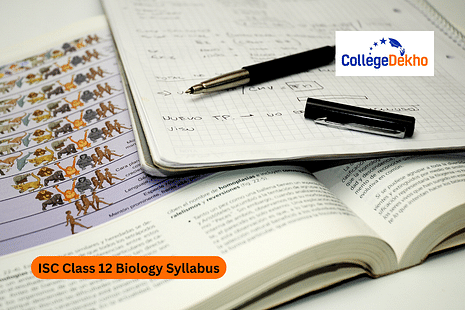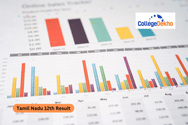- About ISC Class 12 Biology Syllabus 2024-25
- ISC Class 12 Biology Syllabus 2024-25 Download PDF
- ISC Class 12 Biology Syllabus 2024-25 Course Structure
- ISC Class 12 Biology Syllabus 2024-25 Units
- ISC Class 12 Biology Syllabus 2024-25 For Internal Assessment
- ISC Class 12 Biology Question Paper Design 2024-25
- ISC Class 12 Biology Books 2024-25
- Preparing For ISC Class 12 Biology Board Exam 2025
- Faqs


Never Miss an Exam Update
About ISC Class 12 Biology Syllabus 2024-25
ISC Class 12 Biology Syllabus 2024-25 has been divided into two papers: Theory and Practical. Paper 1: The theory paper will be three hours long and worth 70 marks. A total of 30 marks are awarded for the practical exam which comes under Paper 2. There are a total of 5 units in ISC 12th Biology Syllabus, out of which Unit 1 - Reproduction has the maximum weightage of marks i.e. 16 followed by Units 2 and 5 with a weightage of 15 marks each. Students can download the official PDF of the syllabus by visiting the website of CISCE at cisce.org and use it to actively prepare for the exams. Students can use ISC Class 12 Biology Sample Paper 2024-25 available on the official website to revise for the board exams according to the changes made by CISCE in the exam format.
ISC class 12 board exams 2025 will be conducted in February or March 2025. Students after waiting for the detailed date sheet to be released by CISCE. Once the ISC 12th Time Table is out, students must plan out their studies accordingly to gain a higher percentage. Check more information about the ISC Class 12 Biology Syllabus 2024-25 here:
ISC Class 12 Biology Syllabus 2024-25 Download PDF
The class 12 biology syllabus is extensive and challenging, and it will help students get a deep grasp of biology. By mastering the topics mentioned in the syllabus, students can easily score good marks in class 12. Check here the ISC Class 12 Biology Syllabus 2024-25 PDF:
ISC Class 12 Biology Syllabus 2024-25 Course Structure
Students can refer to the ISC Class 12 Biology Exam Pattern 2024-25 from the table given below:
S. No. | UNIT | TOTAL WEIGHTAGE |
|---|---|---|
1. | Reproduction | 16 Marks |
2. | Genetics and Evolution | 15 Marks |
3. | Biology and Human Welfare | 14 Marks |
4. | Biotechnology and its Applications | 10 Marks |
5. | Ecology and Environment | 15 Marks |
TOTAL | 70 Marks | |
Also Read: ISC Class 12 Biology Previous Year Question Paper
ISC Class 12 Biology Syllabus 2024-25 Units
Students can check the ISC Class 12 Biology Syllabus 2024-25 for each unit from the table given below:
Chapter | Topics |
|---|---|
Reproduction | (i) Sexual reproduction in flowering plants Flower structure, male and female gametophyte development, pollination types, agencies, and examples, outbreeding devices, pollen-pistil interaction, double fertilization, and post-fertilization are some of the topics covered in this chapter. Types of pollination (autogamy, chasmogamy, cleistogamy, geitonogamy, xenogamy), adaptations in flowers pollinated by wind, water and insects. Fruits should be divided into genuine and false categories according to their L.S. (like mangoes and coconuts); Definition, distinctions, and examples of albuminous and non-albuminous seeds; internal structure of dicot (bean) and monocot (maize) seeds. the importance of fruit and seed formation. significance of seed distribution. Post-fertilization activities include embryo development (monocot and dicot); endosperm kinds (cellular, nuclear, and helobial); and perisperm definition. (ii). Human Reproduction The reproductive systems of men and women; the microscopic anatomy of the testis and ovary; gametogenesis—spermatogenesis and oogenesis; the menstrual cycle; fertilization; embryo development up to blastocyst formation; implantation; pregnancy and placenta formation; parturition; and lactation. (iii). Reproductive Health Need for reproductive health and prevention of Sexually Transmitted Diseases (STDs); birth control - need and methods, contraception and medical termination of pregnancy (MTP); amniocentesis; infertility and assisted reproductive technologies.Population explosion, the government's role in population control, contraceptive methods and how they work (natural: periodic abstinence, withdrawal or coitus interruptus, lactational amenorrhea; artificial: barriers, IUDs, oral pills, implants, and surgical methods), the definition of medical termination of pregnancy (MTP) and its causes, and infertility factors. |
2. Genetics and Evolution | (i) Principles of inheritance and variation Mendelian inheritance, chromosomal theory of inheritance, chromosomes and genes, sex determination in humans, birds, and honey bees, linkage and crossing over, sex linked inheritance - haemophilia, color blindness, Mendelian disorders in humans, and chromosomal disorders in humans are some examples of heredity and variation. Chromosomal theory of inheritance; autosomes and sex chromosomes; sex-linked inheritance; with reference to Drosophila (body color: yellow and brown; and color of eyes: red and white); and man (haemophilia and color blindness); definition and significance of linkage and crossing over. Human genetic disorders like phenylketonuria, thalassemia, color blindness, and sickle cell anemia; chromosomal disorders like Down's syndrome, Klinefelter's syndrome, and Turner's syndrome. Mutation: spontaneous, induced, gene (point-transition, transversion, and frame-shift). (ii). Molecular basis of Inheritance DNA packaging, DNA replication, core dogma, transcription, genetic code, translation, gene expression and control - lac operon, human and rice genome projects, DNA fingerprinting, and search for genetic material and DNA as genetic material. (iii) Evolution Origin of life; biological evolution and its supporting evidence (palaeontology, comparative anatomy, embryology, and molecular evidences); Darwin's contribution; modern synthetic theory of evolution; mechanism of evolution - variation (mutation and recombination) and natural selection with examples, types of natural selection; gene flow and genetic drift; Hardy-Weinberg principle; adaptive radiation; and human evolution. |
3. Biology and Human Welfare | (i) Human Health and Diseases The control of pathogens and parasites that cause human diseases such the common cold, dengue fever, chikungunya, typhoid, pneumonia, amoebiasis, malaria, filariasis, ascariasis, and ringworm; Immunology fundamentals: cancer, HIV/AIDS, vaccinations. (ii) Strategies for enhancement in food production Green revolution, plant breeding, tissue culture, single cell protein, biofortification, apiculture, and animal husbandry have all improved food production. Measures for maintaining dairy farms and poultry farms properly; definitions, outlines, and benefits of apiculture and pisciculture. Animal breeding: a brief overview of artificial insemination, multiple ovulation embryo transfer technology (MOET), out-breeding, cross-breeding, and in-breeding. benefits of artificial conception. Brief mention of the green revolution in relation to plant breeding. (iii) Microbes in HumanWelfare In household food processing, industrial production, sewage treatment, energy generation and microbes as biocontrol agents and biofertilisers. Antibiotics. |
4. Biotechnology and its Applications | (i) Biotechnology - Principles and processes Genetic Engineering (recombinant DNA technology). Definition and guiding principles of biotechnology; isolation of genomic (chromosomal) DNA (from bacteria, plants, or animals, by cell lysis); isolation of gene of interest (by electrophoresis); stages of recombinant DNA synthesis; discovery, nomenclature, characteristics, and function of restriction enzymes (EcoRI, HindII); function of ligase; cloning vectors. (ii) Biotechnology and its applications Applications of biotechnology in health and agriculture: human insulin and vaccine production, stem cell technology, gene therapy; genetically modified organisms - Bt crops; transgenic animals; biosafety issues, biopiracy and biopatents. |
5. Ecology and Environment | (i). Organisms and Populations Habitat and niche, population and ecological adaptations, mutualism, competition, predation, and parasitism among population interactions; population features like as growth, birth and death rates, and age distribution. (ii) Ecosystem Ecosystems: patterns, components; productivity and decomposition; energy flow; pyramids of number, biomass, energy; nutrient cycles (carbon and phosphorous); ecological succession; ecological services - carbon fixation, pollination, seed dispersal, oxygen release (in brief). (iii) Biodiversity and its Conservation The following terms and concepts are used to describe biodiversity: concept; patterns; relevance; loss of biodiversity; protection of biodiversity; hotspots; endangered species; extinction; Red Data Book; biosphere reserves; national parks; sanctuaries; and Ramsar sites. (iv) Environmental Issues Air pollution and its control; water pollution and its control; agrochemicals and their effects; solid waste management; radioactive waste management; greenhouse effect and climate change; ozone layer depletion; deforestation; any one case study as success story addressing environmental issue(s). |
ISC Class 12 Biology Syllabus 2024-25 For Internal Assessment
The internal assessment for Biology will be conducted for 30 marks. Check the detailed syllabus from the pointers given below:
- PRACTICAL WORK – 15 Marks
(i) Malvaceae: type – China rose / Hollyhock.
(ii) Leguminosae: subfamily – Papilionaceae – type – Sweet pea/ Pea/ Bean/ Sesbania/ Clitoria (single flower).
(iii)Solanaceae: type – Petunia / Datura / Brinjal Flower / Solanum nigrum.
(iv)Liliaceae: type – Onion or Amaryllidaceae –type – Lily/Spider lily/ Tiger lily/ Tube rose/ Gladiolus.
By dissecting flowers, floral qualities should be described. It is important to teach students how to cut flowers into vertical sections and how to identify their diagrams correctly. It is essential to know how to correctly locate the mother axis while developing flower diagrams. The formula for flowers should be written accurately. It is important to identify the correct family, justify, and describe how to cut the T.S. and L.S. of the ovary, and then draw the appropriate labeled figure.
Students should be familiar with several examples of plants from each family that are significant to the economy. The proper scientific names for the plants must be used to support any examples of common names.
2) Simple biochemical and physiological experiments
(ii) Study of soils from two different sites. Collect soil samples from two different areas and make a comparative study of their texture, moisture content, humus content, water-holding capacity, and pH.
(iii) Analyze the impact of enzyme activity on starch solution at three different pH levels and temperatures. Effect of the enzyme (amylase/diastase) action on the starch solution at three different temperatures (low: below 10°C, optimal: 37°C, and high: over 70°C).
(iv) To isolate DNA from available plant material. Isolation of DNA from spinach leaves, green pea seeds, pulp of banana and papaya.
3) Slide preparation
(ii) T.S. of the ovary of any locally available flower, to show marginal/axile placentation.
(iii)T.S. of a hydrophyte stem.
(iv) T.S. of a xerophytic leaf (Nerium).
(v) L.S. of monocot and dicot seed (soaked seeds of maize/wheat, pea/ bean.)
4) Spotting: Each spot will have three minutes to identify, draw a diagram with labels, and write at least two defining traits.
(a) Permanent slide of a mammal's ovary.
(b) A mammal's testis (permanent slide).
(c) Germinating pollen grain (slide/chart).
(d) T.S. of the ovary to demonstrate the kind of placentation (parietal, basal (LS), axile, and marginal).
(e) T.S. of a mammal's blastula or blastocyst (chart or slide).
(f) Complete mount of sporozoites from Plasmodium (slide/chart).
(g) Whole mount of Entamoeba histolytica trophozoite (slide/chart).
(h) Preserved specimen/ chart/ model of Ascaris.
(ii) Discuss how plants and animals have adapted to their environments. One animal and one plant from xeric and watery ecosystems are represented by models, virtual images, or charts. Hydrilla, cactus, fish, and camel are a few examples.
(iii) Flowers with various insect and wind pollination adaptations.
- PROJECT WORK AND PRACTICAL FILE – 15 Marks
ISC Class 12 Biology Question Paper Design 2024-25
- There are four sections in the paper: A, B, C, and D. Internal choices have been provided in one question each in Sections B, C, and D.
- Section A consists of one question each carrying one / two mark(s).
- Section B consists of seven questions each carrying two marks.
- Section C consists of seven questions each carrying three marks.
- Section D consists of three questions each carrying five marks.
ISC Class 12 Biology Books 2024-25
There are some books the students can consider to revise for the board exams. Check out some suggestions from the pointers given below:
- Nootan ISC Board Biology Text Book For Class 11th - Academic Year 2024-25 By Dr. H.C. Srivastava - Nageen Prakashan
- All In One Class 12th Biology for ISC Exam 2025
- BIOLOGY Simplified NCERT Class XII
- A Textbook of ISC Biology Class 12 By Sarita Aggarwal
- ISC Question Bank Class 12 Biology Book (For 2025 Board Exams)
- Biology Most Likely Question Bank ISC Class 12 for 2025 Exam
- Arihant ISC Sample Question Papers Class 12 Biology Book for 2025 Board Exam
- NCERT Solutions - Biology for Class 12th
Preparing For ISC Class 12 Biology Board Exam 2025
To prepare for the Biology paper, students can consider the following tips and tricks:
- Complete your syllabus on time so that you have enough days to revise for the board exam using the sample papers available online.
- Make sure to practice your diagrams and neatly label them. Students who draw diagrams with every answer will be provided with full marks.
- Understand the concepts clearly and make sure that you are taking notes after every lecture to retain the information and revise during the exams.
- Use flashcards to remember important definitions and words. This will also help you to revise at the last moment without opening the books again and again.
- Make sure that you are taking the help of side books to understand various concepts in detail. Sometimes the book allotted by your schools or CISCE may have limited information about lesser-known topics.
Students must download the latest ISC Class 12 Biology Syllabus 2024-25 to study for the board exam. There may be a few changes in the curriculum so the students must only refer to the latest curriculum PDF uploaded by CISCE on their official website.
FAQs
Because the caliber of every student is different, it is difficult to give a definite answer about the number of days required to complete the ISC Class 12 Biology Syllabus 2024-25. Students must start studying for the exams as soon as the curriculum is available on the official website and complete the studies at least one month before exams to revise in the last month.
CISCE has released the revised ISC Class 12 Biology Syllabus 2024-25 on their official website. Students must prepare for the exams only considering the latest curriculum PDF uploaded on the official website accessible at cisce.org.
As per the ISC Class 12 Biology Syllabus 2024-25, the internal assessment will be conducted for 30 marks which will include 15 marks for the practical exam and 15 marks allotted for project work and file.
As per the ISC Class 12 Biology Syllabus 2024-25, 5 units are included in the curriculum. These are Reproduction for 16 marks, Genetics and Evolution for 15 marks, Biology and Human Welfare for 14 marks, Biotechnology and its Applications for 10 marks, and Ecology and Environment for 15 marks.
Was this article helpful?















